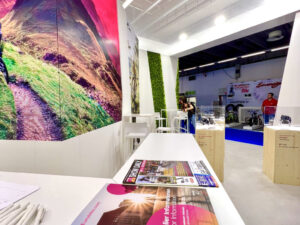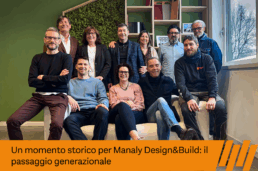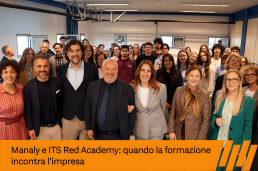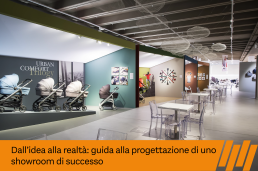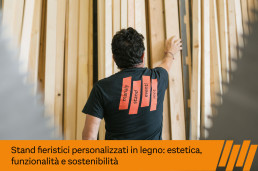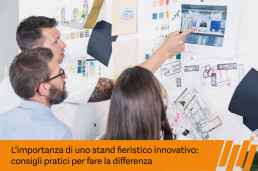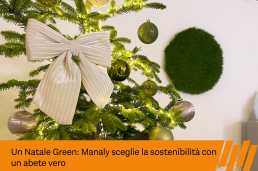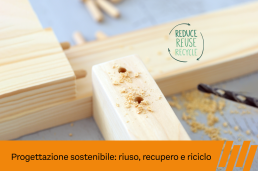Host Milano 2025: Manaly’s Projects for Delfin, Giganplast and Bravo Inox
The 2025 edition of Host Milano, the international benchmark for the professional hospitality industry, has just come to a close. As it does every two years, the fair brought together key players from the Ho.Re.Ca. world, with exhibitors from all over the globe ready to showcase solutions and trends for a future that is increasingly efficient, sustainable, and connected.
This year, among the pavilions of the Rho exhibition center, Manaly closely followed three stands: Delfin, Giganplast, and Bravo Inox—three very different companies, united by the same goal of enhancing their brands through functional, welcoming, and highly recognizable exhibition spaces.
Read on to discover more about their stands!
Giganplast: Open Space and Visual Lightness at Host Milano 2025
The Giganplast stand perfectly reflected the company’s philosophy: practicality, solidity, and attention to detail, with a touch of lightness that caught visitors’ eyes.
Specializing in plastic products for restaurants and hotels, Giganplast chose an open and visually permeable layout that welcomed the public without creating barriers. The walls, made of metal frames, were designed to define the space without closing it off, ensuring visibility from every angle of the fair’s aisles.
Inside, the layout emphasized a large relational area, with tables and supports displaying smaller products. To bring rhythm and structure to the space, vertical panels featuring graphics positioned at height made the brand instantly recognizable even from afar.
The result was a balanced stand—structurally well-defined, yet at the same time welcoming and transparent.
Bravo Inox: Volumes and Movement
Bravo Inox is a long-standing Manaly client, and this year’s stand represented another step forward in their ongoing collaboration in exhibition design. The company, which produces sinks, fry tanks, and stainless-steel equipment for the catering industry, has always prioritized space usability, even with large-sized products. 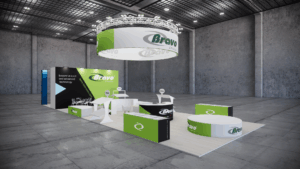
For Host Milano 2025, the stand was designed with two-tiered display units and large flat volumes, including the brand’s signature semicircular tables, arranged to give order and centrality to the products while preserving visitors’ freedom of movement. Openings on all sides allowed for access and interaction from any direction, consistent with the idea of an open and dynamic space.
A key highlight this year was the brand refresh: updated graphics, brighter colors, and a more energetic visual identity. Completing the setup was a circular overhead banner designed to ensure maximum visibility from a distance, reinforcing the brand’s presence across the pavilion.
Delfin at Host Milano 2025: Visual Identity and Pride in “Made in Italy”
The Delfin stand stood out for its strong visual and communicative impact. With two open sides, the space was designed to welcome visitors and maximize visibility, highlighting the brand’s strength and graphic consistency. 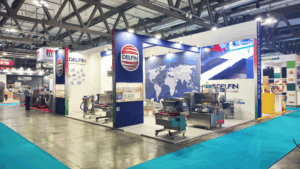
Graphics played the starring role—dominated by the brand’s blue and red colors and a strategic use of the logo, prominently displayed across main surfaces. Column showcases featured packaged products made using Delfin’s own machines, while a dynamic LED wall brought the stand to life with visual content.
This year, a touch of Italian pride gave the project even more character: graphics inspired by the Italian flag celebrated the brand’s heritage and quality, proudly emphasizing that everything has been Made in Italy since 1996.
The design of these three stands at Host Milano 2025 emphasized functionality, visual lightness, and brand recognition—three key elements for standing out in a competitive context like Host.
The experience at the fair reaffirmed how essential it is to manage multiple projects in parallel while maintaining coherence, attention, and care in every stage—from the initial concept to final realization. In a dynamic setting like events and exhibitions, the ability to adapt and coordinate different stands, even across industries and fairs, is what truly allows each brand and space to shine.
If you’re looking to design a stand or installation that effectively tells your company’s story, get in touch with us! We’ll help you develop a tailor-made project that reflects your identity.
Environmental Sustainability Trade Fairs in Italy and Europe: A Guide to Key Events
Environmental sustainability is now a central theme in corporate strategies and consumer choices. In Italy and across Europe, numerous specialized trade fairs offer a unique opportunity to discover innovations, technologies, and the most advanced solutions for a more sustainable future. In this article, we present the most relevant events at both national and European level, along with some of our stands created specifically for these occasions.
Keep reading to learn more!
Environmental Sustainability Trade Fairs in Italy
Italy hosts some of the most important events dedicated to sustainability, renewable energy, and the circular economy. Among the key events in the sector are:
 Klimahouse (Bolzano): Recognized as a benchmark for sustainable building, Klimahouse is held every year in Bolzano, offering a stage for the most innovative technologies in energy efficiency and green architecture. For many years, we have partnered with Diquigiovanni for this fair. Discover our latest project by clicking here!
Klimahouse (Bolzano): Recognized as a benchmark for sustainable building, Klimahouse is held every year in Bolzano, offering a stage for the most innovative technologies in energy efficiency and green architecture. For many years, we have partnered with Diquigiovanni for this fair. Discover our latest project by clicking here!- Key Energy Transition Expo (Rimini): A leading event for energy transition, Key Energy provides a comprehensive overview of renewable energy, electric mobility, and smart solutions to reduce carbon emissions. In addition to conferences and workshops, this fair is an ideal showcase to discover new products and forge partnerships with innovative companies in the sector.
- ECOMONDO (Rimini): The largest Italian trade fair dedicated to the circular economy, ECOMONDO brings together businesses, experts, and institutions to present the best solutions in waste management, recycling, and industrial sustainability. The event also features training sessions and talks with international experts, making it a key appointment for those working in the environmental sector.
- MyPlant & Garden (Milan): A must-attend event for professionals in the green and horticultural sector, MyPlant & Garden promotes sustainable practices for designing urban and non-urban green spaces. Here you can find innovative solutions for landscaping and urban greenery, an increasingly important aspect in modern cities.
Major European Sustainability Trade Fairs
At the European level, several events stand out for their focus on sustainability and green innovation. Among the most relevant are:
- Ambiente (Frankfurt, Germany): One of the most prestigious international fairs for sustainable design and the circular economy, focusing on eco-friendly solutions in the home and lifestyle sectors. Stefanplast, one of our long-standing clients, relies on us at Ambiente for the creation of its modular and versatile stand, perfect for adapting to multiple events. Learn more by clicking here!

- Eurobike (Frankfurt, Germany): The world’s leading event dedicated to sustainable two-wheeled mobility, Eurobike showcases technological innovations and new business models for green transport. One example of a stand here was HGears, a project where sustainability and technology blend seamlessly. Read the full case study by clicking here!
- GreenTech Festival (Berlin, Germany): Founded by former Formula 1 driver Nico Rosberg, the GreenTech Festival brings together companies, startups, and investors to present cutting-edge technologies in renewable energy and the circular economy. The event goes beyond exhibitions, also featuring conferences and awards for the most significant environmental innovations.
Why Attend These Fairs
Attending these events offers a unique opportunity for companies, professionals, and sustainability enthusiasts to discover new technologies, connect with industry experts, and develop strategic collaborations. Moreover, these trade fairs play a key role in raising public awareness, promoting innovative solutions for a greener future.
If you are looking for green solutions for your stand or event, trust Manaly. For over 40 years, we have been designing and building custom stands with special attention to environmental sustainability. We are PEFC and Legno Veneto certified, ensuring complete traceability of the wood we use—from the forest to the finished product.
Contact us for more information and find out how we can help you bring your project to life!
A Historic Moment for Manaly Design&Build: The Generational Transition
After more than 44 years of activity in the trade show and exhibition industry, Manaly Design&Build is facing one of the most significant challenges in its history: the generational transition. A transformation that is both natural and strategic, officially initiated in 2022 and set to be completed by 2028.
What we are experiencing is not simply a change in the names of the partners, but a gradual and shared transition that deeply involves our cooperative identity. The future of the company has been entrusted to five new individuals, all internal and already active in different company departments, who are progressively taking on the role of partners alongside the longstanding members. Our history has taught us that the best transformations stem from participation and collaboration — and that’s exactly how we’ve chosen to approach this new chapter.
This phase of change represents an opportunity: to renew our vision, to enhance the accumulated know-how, and to build new paths while remaining rooted in continuity.
A Cooperative Model That Looks to the Future
Manaly Design&Build is a worker cooperative, a model that has always placed people and active participation at its core. Every member is an integral part of the company’s management: decisions are made collectively, responsibilities are shared, and so are successes. This cooperative spirit has allowed us, over the years, to build a solid, innovative company capable of adapting to market evolution.
The same cooperative approach is guiding the generational transition. In fact, it was our long-time president, Alessandro Montanari, who initiated a deep reflection before launching the process: was there truly a foundation on which to build the future? The first answer came from his son Pietro, who demonstrated a vision aligned with the company’s values and a strong drive toward innovation. Alongside him, other skilled and passionate professionals joined the project as new partners.
Five New Partners, One Shared Vision
With the entry of the new partners — Pietro Montanari, Alessandro Peron, Serena Nicente, Alessandro De Tomasi, and Alberto Dalla Barba — Manaly Design&Build aims to consolidate past successes and look ahead with fresh ideas, enthusiasm, and new skills. Each of them brings a wealth of experience, but above all, a strong will to build a sustainable, future-oriented company together.
The new generation’s priorities are clear: strengthen the company’s market positioning, implement digital strategies, and expand the service offering with a strong focus on sustainability and process efficiency. However, people, teamwork, and the value of cooperation will always remain at the heart of our approach.
We’ve shared this important milestone in an article published by Industria Vicentina, the magazine of Confindustria Vicenza. It’s an important recognition that makes us proud and gives us visibility in the local business community. It’s an opportunity to reflect on who we are and where we want to go.
Read the full article published in Industria Vicentina and discover how we’re building the future of Manaly Design&Build, while staying true to our cooperative roots.
Click here!
For over 40 years, we’ve been designing and building exhibition spaces. If you’re looking to create a trade show stand or organize an event, rely on Manaly to design your custom-built stand: we’ll support you from start to finish, transforming your vision into reality. Contact us!
Manaly and ITS Red Academy: when education meets industry
On March 26, Manaly enthusiastically took part in a valuable educational event organized by ITS Red Academy in collaboration with Confindustria Vicenza and Confartigianato Imprese Vicenza. The initiative, held at the Antonio Canova Institute in Vicenza, involved fifty students from the “Marketing Manager - Furniture System” course, who worked on real projects commissioned by seven companies in the sector, including ours. Keep reading to find out more!
A workshop connecting young talent and local businesses
The event aimed to build a direct bridge between education and the professional world. Divided into teams, the students presented digital and sustainable marketing strategies they had developed in the weeks prior, based on briefs provided directly by partner companies. It was a practical opportunity to tackle real market challenges and to experience working side-by-side with industry professionals.
Along with us at Manaly, participants included companies such as FBE Woodliving, LegnoPan, Ongaro Serramenti, Pozza 1865, Adeptev, and Baggio Felice. The initiative received the support and presence of prominent local figures, including Cristiano Perale, President of ITS Red Academy; Elisa Barausse and Paola Zanotto, Presidents of the Wood-Furniture sections of Confindustria and Confartigianato Vicenza respectively; and Member of the European Parliament Elena Donazzan. A clear demonstration of how high-level technical education today represents a strategic value for the local economy.
Manaly’s experience with ITS Red Academy
For Manaly, this collaboration was a valuable opportunity for openness and exchange. The students were welcomed to our headquarters to get a closer look at our company, explore the different production departments, and understand our work philosophy. They analyzed who we are, what we do, and how we communicate our brand, bringing a fresh and curious perspective to all of our activities.
We asked them to work on a communication project not directly tied to our core business — the design and creation of custom exhibition spaces — but related to an innovative idea we are developing internally: a line of sustainable pre-assembled stands. The project aims to combine functionality, aesthetics, and environmental responsibility. Although still in its early stages, the students approached it with great enthusiasm, delivering effective and stimulating communication and marketing proposals.
The experience was beneficial for us as well: it allowed us to see how the new generations interpret values such as sustainability, innovation, and communication. It was a genuine exchange, from which we gained valuable insights to continue improving.
Education, business, and sustainability: a shared vision
The event organized by ITS Red Academy perfectly reflects what Manaly believes in: a constant dialogue between education and business, where learning is never an end in itself, but a driver of growth for the entire production system. The practical and hands-on approach of ITS programs, developed in close synergy with companies, prepares young professionals who are truly ready to meet market demands.
Our involvement in this initiative reaffirms how important it is to invest in the future. Even the parallel project the students worked on stems from a real need: reducing the environmental impact of the trade fair sector by introducing more mindful, modular, and reusable solutions.
Manaly will continue to support projects that prioritize education, sustainability, and innovation, with the belief that true progress comes from listening to and involving the new generations.
Did you enjoy this article about education and sustainable exhibition design?
If you're considering building a custom trade show stand or would like to learn more about sustainability in exhibition setups, the Manaly team is here for you. Contact us!
From idea to reality: a guide to designing a successful showroom
Opening a showroom is not just about displaying products; it’s about creating an immersive environment that enhances the brand and provides an engaging customer experience. An effective exhibition should lead visitors through an emotional journey, highlighting the company’s strengths and encouraging purchases. In this guide, we will explore the three fundamental aspects of designing a successful showroom: strategic setup, the use of technology, and the choice of location.
Setup and Layout for a Successful Showroom
A well-structured showroom offers a multisensory experience that captures attention and invites discovery. The layout should be designed to promote a logical and intuitive flow, avoiding chaotic or overcrowded spaces. Dividing the showroom into themed areas helps to enhance collections and tell the brand’s story.
The company’s visual identity should be clearly reflected through the consistent use of colors, materials, and graphic elements. To make the environment more engaging, you can use:
- Custom panels to narrate the brand’s story;
- Dynamic displays to maintain customer interest;
- Experiential points where customers can interact with products;
- Strategic placement of bestsellers to maximize attention;
- Constant updates to the setup for a fresh experience.
Lighting and Technology for Engagement
Lighting is a key element in enhancing products and creating an atmosphere suited to the target audience. A combination of warm and cool lighting can evoke different emotions: warm lights convey comfort and hospitality, while cool lights provide a modern and technological look. Spotlights and diffused lighting help highlight details without creating shadowy areas.
Technological innovation is another essential factor. Interactive screens, augmented reality, and personalized digital displays offer an immersive experience, turning the showroom into a dynamic and engaging space. Visitor behavior analysis through motion sensors and tracking tools allows for the optimization of the shopping journey and improvement of sales strategies.
One successful showroom we designed is for Inglesina, featuring various illuminated product areas and a spacious central area guiding the exhibition path. Learn more by clicking here!
Location and Space Optimization
Choosing the right location is crucial for a successful showroom. It should be easily accessible and situated in an area with high visitor traffic or a strategic setting for the target audience. Proximity to shopping centers, design districts, or industrial hubs can increase visibility and attract potential customers.
Space optimization also plays a key role: even a small showroom can be highly effective if designed with an intelligent layout. Utilizing vertical space, adopting modular solutions, and maintaining a balance between filled and open areas help create an airy and well-organized environment. The integration of guiding visual elements, such as strategic signage or defined pathways, facilitates customer movement and enhances the overall experience.
Conclusion
A successful showroom is not just a product display but an experience that strengthens the connection between brand and customer. From meticulous setup to technology integration and strategic location choice, every detail contributes to the success of the exhibition space. Investing in strategic design allows for the creation of an appealing and functional environment that boosts sales and customer loyalty.
For the best results, partnering with industry experts is key to transforming your showroom into a market benchmark.
Want to see more examples of showrooms or retail spaces we’ve designed? Click here!
If you’re interested in creating a custom showroom, Manaly is here to assist you from start to finish, turning your vision into reality. Contact us!
Custom wooden exhibition stands: aesthetics, functionality and sustainability
Wood is becoming the undisputed star in the design of custom exhibition stands, thanks to its ability to combine aesthetics, sustainability, and customization. Its warm texture transforms a stand into a welcoming space, inviting visitors to step into a pleasant and engaging atmosphere. Keep reading to learn more about custom wooden exhibition stands!
The warmth of wood in custom exhibition stands
Wood offers a versatile aesthetic that naturally adapts to any style, from rustic to modern. Its natural texture adds a touch of originality, creating a pleasant contrast with the industrial materials that often dominate exhibition spaces.
But wood in custom exhibition stands is much more than just an aesthetic element—it is a living material that is easy to work with and customize. With wood, it is possible to create elements that reflect a brand’s identity, such as carved logos, custom displays, and uniquely designed furnishings. This flexibility allows companies to stand out from the competition and effectively communicate their uniqueness.
Environmental sustainability: an added value for the brand
In an era where environmental awareness is at an all-time high, choosing wood for custom exhibition stands means making a sustainable and responsible choice.
Using wood sourced from sustainably managed forests is a strong statement of a company’s commitment to protecting the planet. That is why here at Manaly, we are PEFC e Legno Veneto certified. This commitment allows us to guarantee complete traceability of the wood, from the forest to the finished product. Learn more about our approach by clicking here!
A concrete example of how wood can be integrated into an industrial context with a sustainable perspective is the Ferretto stand at Mecspe 2024.
Together with the mechanical engineering company, we chose to create part of the back wall in milled PEFC-certified wood, contrasting with the rest of the steel wall, creating a fascinating dualism between materials. Discover more in the case study by clicking here!
Practical Benefits Beyond Aesthetics and Sustainability
In addition to aesthetic and environmental advantages, wood also offers practical benefits. It is a lightweight and easy-to-work material, simplifying the assembly and disassembly of exhibition setups.
Engaging Visitors in Exhibition Stands
Wood has the power to create a connection between people and nature. Its presence in an exhibition stand conveys a sense of warmth and hospitality, encouraging visitors to stop, explore, and interact. The tactile sensation of wood, combined with its reassuring aesthetics, stimulates the senses and fosters conversation, turning a stand visit into a memorable experience.
A perfect example is the Diquigiovanni stand at Klimahouse 2023. Wood played a key role in creating a healthy, comfortable, and sustainable environment, perfectly highlighting the showcased product. Check out the full case study by clicking here!
Moreover, choosing wood for custom exhibition stands enhances the integration of digital technologies, such as interactive screens embedded within the structures or dynamic elements that respond to visitors’ movements, increasing engagement.
Custom Wooden Exhibition Stands: A Strategic Choice
Integrating wood into custom exhibition stands is a strategic choice that goes beyond aesthetics. It means communicating a brand’s values, creating an engaging experience for visitors, and demonstrating a concrete commitment to environmental sustainability. Wood, therefore, proves to be a powerful tool for standing out in an increasingly competitive exhibition landscape.
Did you find this article on custom wooden exhibition stands helpful? If you’re interested in designing an exhibition stand or event, trust Manaly to create a tailor-made exhibition stand. We will support you from start to finish, transforming your vision into reality. Contact us!
The importance of an innovative trade show booth: practical tips to make a difference
Participating in a trade show is not merely about occupying an exhibition space; it’s a unique opportunity to present yourself to the public in a memorable way. Our role, as specialists in trade show booth setups, is to transform your vision into a space that attracts, engages, and converts visitors. Below, we share some practical guidelines to design a winning booth and maximize the potential of every trade show event.
A design that speaks for you
A trade show booth isn’t just an area to showcase products or services—it’s your brand’s business card. A well-thought-out design should reflect your company’s identity in an original way, combining aesthetics and functionality. Why is design so important?
- Customization: Your booth should tell who you are and what you do at a glance. Every element, from colors to materials, must align with your brand image.
- Technological Innovation: Tools like augmented reality, touch screens, and interactive applications are not mere gadgets but powerful tools for creating genuine connections with visitors.
- Sustainability: Using recyclable materials and modular solutions communicates a strong commitment to the planet, a value increasingly appreciated today.
Have you ever thought about creating an immersive experience? Check out the immersive booth we designed for the Veneto Wood Consortium at the Progetto Fuoco 2024 event. Click here!
Location matters!
Not all exhibition spaces are created equal. The location of your booth can mean the difference between being noticed or overlooked. How do you choose the ideal spot?
- Strategic Location: Aim for a space near main entrances, high-traffic areas, or next to booths of complementary and related brands.
- Appropriate Size: A booth proportionate to your message and budget is more effective than a space that is too large or too small. Balance is key.
- Smooth Layouts: Design an intuitive internal layout that guides visitors through your booth without causing confusion. A well-planned flow helps tell your story and highlight your products.
When it comes to selecting the location and designing the layout, relying on a professional can make all the difference. Expert advice ensures every element is optimized to maximize your booth’s impact.
Planning: the secret to success
Behind every successful trade show booth is careful and targeted planning. Every detail counts, and nothing should be left to chance. Here are our tips:
- Clear Objectives: Before you start, define what you want to achieve from your participation. Is it generating leads, increasing brand awareness, or launching a new product? Every decision should be guided by these objectives.
- Targeted Promotion: Don’t wait for the day of the trade show to make an impression. Use social media, email marketing, and advertising campaigns to announce your presence and invite potential customers to your booth.
- Team Training: Your staff is the heart of your booth. Ensure they are well-prepared, informed, and motivated to represent your brand at its best.
Creating a trade show booth is not just about building a structure—it’s about crafting an experience. We handle everything: from ideation to design, from production to logistics and on-site assembly. Our goal is to ensure that your booth is not only visually appealing but also effective.
Take a look at our projects by clicking here!
Participating in a trade show is a significant investment, but with the right strategy, you can turn this opportunity into a great success. Trust professionals who can interpret and bring your vision to life.
Contact us to design your next trade show success together!
A Green Christmas: Manaly chooses sustainability with a real fir tree
Christmas has always been a special time for us at Manaly. This year, however, we’ve decided to make it even more meaningful by taking a concrete step toward sustainability with a truly Green Christmas.
In previous years, we created Christmas structures like trees and fireplaces in our carpentry workshop, personalizing them to make them uniquely ours while avoiding waste. This creative and responsible approach allowed us to celebrate the season in an original way. This year, we’ve taken it a step further by fully embracing sustainability with the use of a real fir tree (Nordmann fir, native to the Caucasus), thanks to our collaboration with Fattoria del Legno by Andrea Zenari. This Veneto-based company is dedicated to sustainable forest management and promoting the culture of wood.
We’ve worked with Andrea Zenari before, participating in a training course to deepen our knowledge of wood species, their characteristics, and the best ways to use them. That experience inspired us to make Christmas another opportunity to promote sustainability.
Keep reading to learn more!
Choosing a Real Fir Tree for a Green Christmas
This year, we opted to rent a real fir tree—a choice that combines tradition, innovation, and environmental respect. Thanks to Fattoria del Legno, the real tree is delivered for the holiday season and then returned to its natural habitat, where it is replanted. This approach allows us to:
- Reduce waste by avoiding the purchase of artificial trees.
- Promote responsible natural resource management.
- Support the local wood industry, which is essential for caring for mountain territories and combating hydrogeological instability.
- Preserve the tradition of Christmas trees with an innovative and sustainable approach.
A real tree is not only an aesthetic choice but also a sustainable one. Real fir trees, even when cut, continue to absorb CO₂, release oxygen, and improve air quality. This is confirmed by PEFC Italy, the leading forest certification system, which Manaly is proud to be certified by.
Real Trees vs. Artificial Trees
While artificial trees may seem like a sustainable option for multi-year use, their environmental impact is significant. Often made from non-recyclable plastic and produced in distant countries, their life cycle generates greenhouse gas emissions four times higher than that of a real fir tree. Additionally, long-distance transport further exacerbates their environmental footprint.
Choosing a real tree grown in Italy supports the local economy and contributes to responsible land management.
From Christmas to Exhibition Spaces: Sustainability in Our Projects
For Manaly, sustainability is not just about Christmas—it’s a core value that guides our work in designing exhibition spaces, fairs, and events. Just as we’ve chosen a greener Christmas with a real fir tree, we prioritize environmentally friendly solutions in our setups without compromising aesthetics and functionality.
Using natural materials, favoring local suppliers, and designing modular, reusable structures are choices that help reduce the environmental impact of our projects. The same care we take in selecting a sustainable Christmas tree is reflected in creating spaces that blend innovation, beauty, and respect for the planet.
Our Invitation to a Green Christmas
This year, we decorated our real fir tree knowing we made the right choice for the environment. It’s a small gesture, but we hope it inspires others to adopt more sustainable solutions too.
Curious to see us in action as we decorate our tree? Take a look by clicking here!
If you’re interested in sustainable design and need help creating a trade fair stand or event setup, we’re here to help—contact us!
Sustainable Design: reuse, recovery, and recycling
In the trade fair and exhibition design sector, the primary challenge today is to integrate innovation and effectiveness with greater environmental awareness. Sustainable design plays a crucial role in this transformation by enabling the development of solutions that combine creativity with environmental responsibility. Designing stands, events, and exhibitions often requires timely, flexible, and highly customized solutions, which inevitably lead to waste and surplus materials. This traditional model, based on “disposable” production cycles, is no longer sustainable, either economically or ecologically.
This is where the concepts of reuse, recovery, and recycling come into play—principles that not only reduce environmental impact but can also offer opportunities to improve service quality, strengthen corporate image, and provide added value to clients.
At Manaly, we've been working on this for some time—keep reading to discover where we’ve already applied these principles!
Reuse: optimizing resources for sustainable design
Reuse involves extending the life of materials and components, preventing them from becoming waste after just one use. In trade fair setups, this can translate into using modular structures that can be dismantled, reassembled, and adapted to new projects. For example, wooden panels, aluminum profiles, and other elements can be customized for different events while maintaining high aesthetic and functional quality. This practice not only reduces costs for both companies and clients but also demonstrates a concrete commitment to more responsible resource management.
At Manaly, our furniture rental service is a concrete example of sustainable design: furniture and accessories are provided to clients for fairs and events and are returned after use to be reused in new projects.
Recovery: long-lasting trade fair installations
Recovery differs from reuse in that it focuses on designing durable and versatile structures from the outset. In other words, installations are designed to be dismantled and reused without compromising quality or functionality. This approach is particularly useful for brands that regularly participate in fairs or events and need a consistent and recognizable visual identity.
A concrete example of sustainable design is the projects created for Stefanplast and Mavolo Beverages – Anthology. For these companies, we designed modular and durable exhibition structures meant to be reused over time and adapted to different spaces and contexts, such as the fairs and events scheduled in future years.
These setups combine aesthetics and practicality, ensuring both sustainability and brand continuity. Click here to read the case studies: Stefanplast and Mavolo Beverages – Anthology.
Recycling: turning waste into resources
Recycling is the third pillar of a sustainable approach in our industry. When materials or components reach the end of their life cycle, it is essential to manage them responsibly to avoid waste. This requires selecting recyclable materials during the design phase: plastic, metals, certified wood, and fabrics can be effectively processed and transformed into new resources.
At Manaly, we ensure that all waste generated by our projects is directed toward recovery. Through careful management of the material lifecycle, we can confidently state that our environmental impact related to waste management is zero.
These three principles represent a new perspective for innovating the trade fair and event design sector, improving its efficiency, competitiveness, and adaptability in a market increasingly focused on sustainability.
For us at Manaly, sustainable design is not just a challenge but a concrete vision for the future.
If you're interested in sustainable design and need to create a trade fair stand or event setup, we're here to help, contact us!
Custom-made stands: carpentry at the service of exhibition design
In the world of exhibition setups, customization is a key factor in standing out and leaving a lasting impression on visitors. Creating custom stands doesn’t just mean choosing colors or materials, but designing solutions that reflect a brand’s identity and are perfectly functional for the event or trade show.
The carpentry workshop plays a crucial role in this process, offering the ability to create tailor-made projects with artisanal precision and technological innovation.
Keep reading to discover how carpentry enables the creation of custom stands for trade shows and events!
The role of carpentry in creating custom stands
In the context of exhibition setups, carpentry is a key element in the creation of custom stands. Every project starts with an idea or vision, and the carpentry workshop’s job is to translate these ideas into physical structures that capture the essence of the brand on display.
Thanks to woodworking, it’s possible to build display elements that not only draw visual attention but are also functional and durable. Wood offers design flexibility that few other materials can match: it can be shaped into unique forms, finished with fine textures, and combined with other materials like metal, glass, or fabrics to create innovative designs.
This ability to craft custom wood pieces allows carpenters to meet every specific customer request. If the brand wants to convey a modern, minimalist image, clean and linear structures can be created; if the goal is to create a warm, welcoming environment, natural woods can be used, perhaps with matte or rustic finishes.
In this context, environmental sustainability is essential for us at Manaly. Where possible, we use PEFC-certified wood and Veneto Wood, ensuring that the materials come from responsibly managed forests. This commitment allows us to guarantee full traceability of the wood, from the forest to the finished product, offering solutions that respect the environment and promote sustainable management of natural resources. Click here to learn more!
How CNC technology is revolutionizing carpentry for trade shows and events
In the field of carpentry for exhibition setups, the use of computer numerical control (CNC) machinery has taken customization to the next level. CNC machines allow wood to be cut, shaped, and engraved with precision that is impossible with traditional manual techniques. This type of technology not only speeds up production processes but also enables extremely complex work to be performed with perfect repeatability, ideal for creating custom stands.
Thanks to CNC technology, carpenters can create custom components perfectly adapted to the client’s design needs.
Another advantage of using CNC machines is the ability to produce rapid prototypes, which improves communication between designers and carpenters, as it allows for changes to be made before final production, ensuring the result fully meets expectations.
Synergy between designers and carpenters: the key to successful stands
Creating a successful custom stand requires close collaboration between designers and carpenters. While designers conceive the layout and visual appearance of the stand, carpenters are tasked with turning these ideas into real structures. This synergy between creativity and technical skill is essential to ensure that the stand is not only aesthetically appealing but also functional and structurally sound.
Our designers work closely with our carpenters to select the most suitable materials, define construction solutions, optimize the display space, and control costs and production times, without compromising on quality or creativity.
In a competitive industry like exhibition setups, the ability to create custom stands is a strategic advantage that can make all the difference in capturing attention and leaving a lasting impression on visitors.
Did you find this article on custom stands helpful? If you also need to create yours, you’re in the right place! Contactc us to bring your project to life!
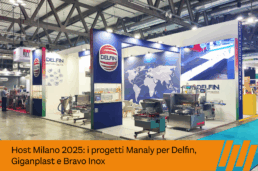
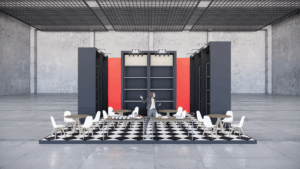
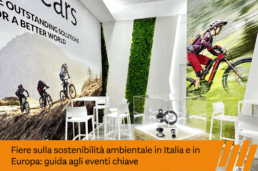
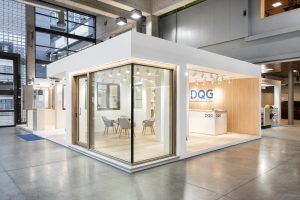 Klimahouse (Bolzano): Recognized as a benchmark for sustainable building, Klimahouse is held every year in Bolzano, offering a stage for the most innovative technologies in energy efficiency and green architecture. For many years, we have partnered with Diquigiovanni for this fair.
Klimahouse (Bolzano): Recognized as a benchmark for sustainable building, Klimahouse is held every year in Bolzano, offering a stage for the most innovative technologies in energy efficiency and green architecture. For many years, we have partnered with Diquigiovanni for this fair. 